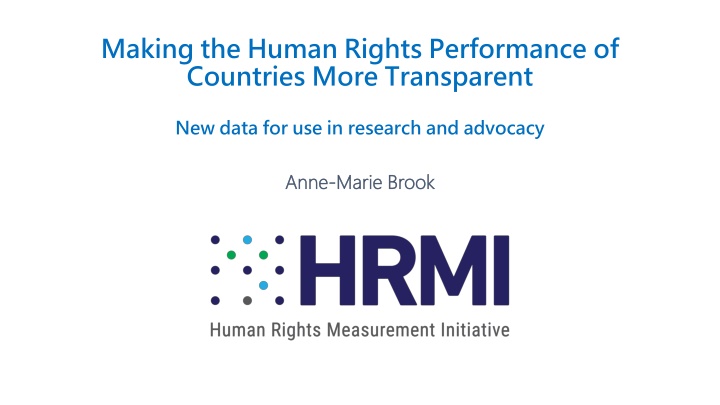Enhancing Transparency in Human Rights Performance Measurement
This information focuses on initiatives like the Human Rights Measurement Initiative (HRMI) that aim to provide new data for researching and advocating human rights issues globally. The HRMI project, founded in 2015, collaborates with various stakeholders and is funded by philanthropic grants. It emphasizes the importance of using metrics grounded in international human rights law, such as the Universal Declaration of Human Rights, to evaluate countries' performance. The data from HRMI is beneficial for policymakers, human rights advocates, researchers, and organizations monitoring Sustainable Development Goals. The methodologies employed for measuring civil and political rights involve expert surveys and statistical models to ensure cross-national comparability. Overall, the emphasis is on making the human rights performance of countries more transparent for informed decision-making and advocacy.
Download Presentation

Please find below an Image/Link to download the presentation.
The content on the website is provided AS IS for your information and personal use only. It may not be sold, licensed, or shared on other websites without obtaining consent from the author.If you encounter any issues during the download, it is possible that the publisher has removed the file from their server.
You are allowed to download the files provided on this website for personal or commercial use, subject to the condition that they are used lawfully. All files are the property of their respective owners.
The content on the website is provided AS IS for your information and personal use only. It may not be sold, licensed, or shared on other websites without obtaining consent from the author.
E N D
Presentation Transcript
Making the Human Rights Performance of Countries More Transparent New data for use in research and advocacy Anne Anne- -Marie Brook Marie Brook
The Human Rights Measurement Initiative (HRMI) Global collaborative project - founded in late 2015 Hosted by Motu Economic and Public Policy Research Contributors include human rights NGOs, academics, and others Funded by philanthropic grants & donations
All HRMI metrics are grounded in International Human Rights Law Universal Declaration of Human Rights (1948) All human beings are born free and equal in dignity and rights. They are endowed with reason and conscience and should act towards one another in a spirit of brotherhood. International Covenant on Economic, Social and Cultural Rights (1976) International Covenant on Civil and Political Rights (1976)
We tend to overvalue the things we can measure and undervalue the things we cannot. John Hayes
Users of HRMI data Policy makers, advisers, and researchers Those who help direct capital flows Human rights advocates Governments & the United Nations Those monitoring SDGs
Civil & Political Rights Methodology Expert survey completed by in-country human rights practitioners Best available information at the cross-national level Survey sent to 20 - 50 potential respondents in each country Encrypted, single response link Survey asks questions about the type, frequency, and distribution of abuse 5 to 12 complete responses received per country Bayesian statistical model aggregates responses into scores Cross-nationally comparable Honest about uncertainty
Economic and Social Rights Methodology Uses publicly available statistics Draws on article 2 of the ICESCR which requires each signatory state to fulfil these rights progressively , to the maximum of its available resources (concept of progressive realisation) Selects summary indicators of each right Can t be gamed Cover the key aspects of the right Metric calculation requires three steps: A) Measure actual enjoyment level of each right B) Measure state obligation level C) Express A as a % of B.
HRMI Website (to access data visualisations) https://humanrightsmeasurement.org/
Who will use HRMI data? HRMI provides a comprehensive tool for shining more light on countries' individual and comparative human rights performance. We also foresee its usefulness in informing UN programming decisions. - Peggy Hicks, Director Thematic Engagement, Special Procedures and Right to Development Division, OHCHR HRMI provides comparative data about countries that staff at Human Rights Watch can use when planning their research, identifying priority issues to work on and crafting advocacy messaging. It is an important effort to provide a wide-angle view of human rights around the globe. - Iain Levine, Deputy Executive Director, Human Rights Watch
Who have we been seeking feedback from? Human Rights NGOs - Amnesty - Human Rights Watch Inter-governmental organisations - OECD - OHCHR - World Bank In-country human rights experts - Pilot countries Journalists - Various Other civil society organisations - Various Private sector - Oxford Analytica - Ecofin
Summary of feedback On CPRs: results look sensible; give us more countries! On ESRs: People have to put on a different thinking cap to understand what the percentage scores show Desire for much greater disaggregation Overall comments Good feedback on data visualisations Journalists, along with much of the public, want rankings
Key priorities over the coming year 2018 - Secure funding for next phase of work - Conduct security audit - Johannesburg co-design workshop (September) - Update ESR metrics and build capacity to conduct more disaggregated analysis - Scale up for expanded CPR data collection 2019 - Roll out expert survey to expanded country list in Feb/March 2019 - Publish updated dataset & visualisations by mid-2019
https://humanrightsmeasurement.org/ Email contacts: anne-marie.brook@motu.org.nz kcclay@uga.edu susan.m.randolph@gmail.com























